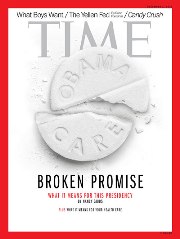Time Magazine Cover Now? 'Broken Promise' Then? 'Paging Dr. Obama'
 The cover for the December 2 issue of Time magazine has been released and it’s a brutal shot at the failed ObamaCare rollout. Underneath a picture of a broken pill with the words “Obama Care” imprinted on it, the headline reads: “Broken Promise, What It Means For This Presidency.” However, back in 2009 Time magazine was singing a different tune when it depicted the President as your friendly family doctor ready to heal a broken healthcare system with the headline: “Paging Dr. Obama.”
The cover for the December 2 issue of Time magazine has been released and it’s a brutal shot at the failed ObamaCare rollout. Underneath a picture of a broken pill with the words “Obama Care” imprinted on it, the headline reads: “Broken Promise, What It Means For This Presidency.” However, back in 2009 Time magazine was singing a different tune when it depicted the President as your friendly family doctor ready to heal a broken healthcare system with the headline: “Paging Dr. Obama.”
In the December 2, 2013 cover story entitled: “Obama’s Race for the Cure, The President’s second term may hinge on how fast his health care reform can recover,” Time’s Nancy Gibbs asks some tough questions of the administration: “The HealthCare.gov website may or may not get fixed on deadline, the senior staff may be booted and rebooted, but it is already too late to avoid a pageant of media scrutiny, Republican merriment, a rebuke even from Bill Clinton and a host of existential questions: Can this policy be saved? What is left of Obama’s second term if it is consumed by fixing an unpopular policy from the first? How could a White House appear so confident and incompetent at the same time?”
But back in 2009 Time’s Katie Pickert, proclaimed that there would be no downsides in ObamaCare for the independently insured. However, with millions already thrown off their plans that prediction is looking worse and worse by the day.  The following is the relevant excerpt from the August 10, 2009 issue of Time:
The following is the relevant excerpt from the August 10, 2009 issue of Time:
Insured Independently
5% Buy health insurance on the open market.
Current Situation
People who purchase insurance on their own pay the highest premiums because they are not in a large risk pool and are evaluated based on their health profile. Choices for coverage are limited, and individuals often must buy insurance with after-tax dollars.
How Reform Could Affect You
THE UPSIDE: Regulation could prevent insurers from setting rates based on health or turning people away because of pre-existing conditions. If offered, a public option is likely to be available for individuals from the start. Lower-income earners could be eligible for federal subsidies to help them purchase coverage.
THE DOWNSIDE: It’s hard for things to be any worse for people now buying their own insurance on the open market. Nearly all major aspects of reform would make this prospect easier and cheaper.
— Geoffrey Dickens is Deputy Research Director at the Media Research Center. Follow Geoffrey Dickens on Twitter.



